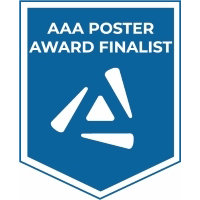Back
ANATOMY
Category: Anatomy
Session: 482 Development & Growth
(482.35) Late Gestation Exposure to PolyI:C-Induced Maternal Immune Activation Results in Sex-Dependent Antiviral Responses in Rat Placenta
Sunday, April 3, 2022
10:15 AM – 12:15 PM
Location: Exhibit/Poster Hall A-B - Pennsylvania Convention Center
Poster Board Number: C150
Introduction: AAA has separate poster presentation times for odd and even posters.
Odd poster #s – 10:15 am – 11:15 am
Even poster #s – 11:15 am – 12:15 pm
Introduction: AAA has separate poster presentation times for odd and even posters.
Odd poster #s – 10:15 am – 11:15 am
Even poster #s – 11:15 am – 12:15 pm
Ruth Thomas (The University of Western Ontario), Cleusa De Oliveira (The University of Western Ontario), Nagalingam Rajakumar (The University of Western Ontario), Stephen Renaud (The University of Western Ontario, Childrens Health Research Institute, Lawson Health Research Institute)
Ruth Thomas, BSc
Presenting Author
The University of Western Ontario
London, Ontario, Canada
Presenting Author(s)
Introduction: Viral infections are a major cause of pregnancy-related complications and can lead to neurodevelopmental deficits in offspring. Viral infections stimulate maternal immune activation (MIA), which disrupts the delicate immune balance required for pregnancy. The placenta is a temporary organ that forms the interface between mom and baby during pregnancy and provides nutrition and protection for the developing fetus. Placental responses to MIA, and how MIA alters placental function, are not well understood. Polyinosinic:polycytidylic acid (PolyI:C), a synthetic double-stranded RNA and viral mimetic elicits MIA in rodent models. PolyI:C-induced MIA is sufficient to cause neurobehavioural consequences in offspring, with male offspring typically exhibiting more severe outcomes than female offspring.
Objective: The aim of this project was to elucidate how MIA affects the immunological profiles of the nascent male and female placenta and brain from a late prenatal PolyI:C stimulation.
Hypothesis: We hypothesize that injection of PolyI:C into pregnant rats at late gestation will induce antiviral responses in the placenta and fetal brain, and these responses will differ between male and female fetuses.
Methods: To test this hypothesis, pregnant Sprague-Dawley rats were injected intravenously with 4 mg/kg PolyI:C (N = 5) or saline (N = 4) on GD18.5. Five hours after injection, placentas and fetal brains were collected. Quantitative RT-PCR was used to measure expression of various genes associated with antiviral responses (e.g., Ifna, Il6, Il1a, Il1b, Tnfa, Ido1, Cxcl10, Rsad2, Cxcl11, Ccl5, and Tlr3) in the placenta. A Student’s t-test was used to compare differences between two means, and a two-way analysis of variance, followed by Sidak’s post-hoc analysis was used to compare differences between treatments and sexes. Means were considered statistically significant when P ≤ 0.05.
Results: PolyI:C-treated male placentas (n = 9) showed significantly higher levels of Rsad2 (2.4-fold), Ifna (2.8-fold), Mx1 (9.4-fold), and Cxcl10 (23.3-fold) compared to saline-treated male placentas (n = 8; P ≤ 0.05). PolyI:C-treated female placentas (n = 10) showed a significant upregulation of Cxcl10 (25.4-fold) and Mx1 (11.4-fold), as well as of Cxcl11 (19.8-fold) and Tnfa (2.3-fold) compared to saline-treated female placentas (n = 8; P ≤ 0.05). Among PolyI:C-treated samples, male placentas showed significantly increased expression of Ifna when compared to female placentas (2.8-fold, P ≤ 0.05).
Conclusion: Our results show that PolyI:C-induced MIA at late gestation stimulates a robust antiviral response in the placenta, including higher levels of Ifna in male placentas than female placentas.
Significance: Future work will characterize PolyI:C-induced antiviral and sex-dependent responses in fetal brains. Overall, this research will provide further insight into MIA-induced susceptibility to pregnancy complications and neurodevelopmental outcomes.
Support or Funding Information
Funding for this project was provided by Canadian Institutes of Health Research.
Objective: The aim of this project was to elucidate how MIA affects the immunological profiles of the nascent male and female placenta and brain from a late prenatal PolyI:C stimulation.
Hypothesis: We hypothesize that injection of PolyI:C into pregnant rats at late gestation will induce antiviral responses in the placenta and fetal brain, and these responses will differ between male and female fetuses.
Methods: To test this hypothesis, pregnant Sprague-Dawley rats were injected intravenously with 4 mg/kg PolyI:C (N = 5) or saline (N = 4) on GD18.5. Five hours after injection, placentas and fetal brains were collected. Quantitative RT-PCR was used to measure expression of various genes associated with antiviral responses (e.g., Ifna, Il6, Il1a, Il1b, Tnfa, Ido1, Cxcl10, Rsad2, Cxcl11, Ccl5, and Tlr3) in the placenta. A Student’s t-test was used to compare differences between two means, and a two-way analysis of variance, followed by Sidak’s post-hoc analysis was used to compare differences between treatments and sexes. Means were considered statistically significant when P ≤ 0.05.
Results: PolyI:C-treated male placentas (n = 9) showed significantly higher levels of Rsad2 (2.4-fold), Ifna (2.8-fold), Mx1 (9.4-fold), and Cxcl10 (23.3-fold) compared to saline-treated male placentas (n = 8; P ≤ 0.05). PolyI:C-treated female placentas (n = 10) showed a significant upregulation of Cxcl10 (25.4-fold) and Mx1 (11.4-fold), as well as of Cxcl11 (19.8-fold) and Tnfa (2.3-fold) compared to saline-treated female placentas (n = 8; P ≤ 0.05). Among PolyI:C-treated samples, male placentas showed significantly increased expression of Ifna when compared to female placentas (2.8-fold, P ≤ 0.05).
Conclusion: Our results show that PolyI:C-induced MIA at late gestation stimulates a robust antiviral response in the placenta, including higher levels of Ifna in male placentas than female placentas.
Significance: Future work will characterize PolyI:C-induced antiviral and sex-dependent responses in fetal brains. Overall, this research will provide further insight into MIA-induced susceptibility to pregnancy complications and neurodevelopmental outcomes.
Support or Funding Information
Funding for this project was provided by Canadian Institutes of Health Research.

